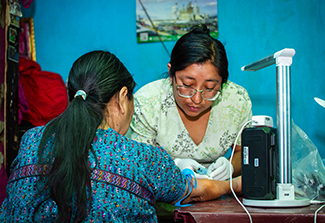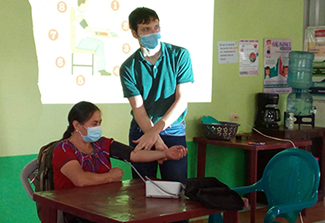Could a task-sharing tool for hypertension control in Guatemala benefit the US?
March/April 2025 | Volume 24 Number 2
 Photo courtesy of Sean DuffyA community health worker provides care for her hypertensive patient in Guatemala.
Photo courtesy of Sean DuffyA community health worker provides care for her hypertensive patient in Guatemala.
An emerging mobile app might help provide access to hypertension diagnosis and management for patients in Guatemala. Even more, this Fogarty-funded project could translate to benefits for patients residing farther north. “There's definitely a potential for the use of this type of clinical decision support to enable task-sharing and to expand access to chronic disease care in the U.S., particularly in rural areas where it can be difficult to see a physician or a physician’s assistant,” said Sean Duffy, MD, MPH, University of Wisconsin-Madison (UW).
Increasing rates of high blood pressure
Hypertension or high blood pressure means the heart has to work harder to pump blood; untreated, this condition can lead to heart attacks, strokes or other serious health problems.
In Guatemala, hypertension is a growing problem. People are living longer—the biggest risk factor for hypertension is age—and they’re also becoming more sedentary while consuming more highly processed foods that are high in salt and contribute to obesity. Managing hypertension is a challenge, particularly in rural areas of Guatemala, because it’s difficult for people there to access a healthcare worker. Often the condition goes undiagnosed, untreated or erratically treated with patients going on and off medications.
Duffy’s project aims to develop and test a new mHealth solution that provides clinical decision support so that community health workers can counsel patients, monitor their hypertension, and manage their medications. The app, which can be used on a cell phone or tablet, delivers easy-to-follow patient protocols to non-physician health workers providing care in rural regions of Guatemala where doctors are few. The app allows remote supervision and review, enabling a physician to verify treatment plans following patient visits.
Effectively, the app means community health workers are not operating in isolation.
A task-sharing technological tool
While developing his app, Duffy and his team consulted with a UW endocrinologist who’d tried, unsuccessfully, to develop nurse-driven protocols for diabetes meds. The problem was the number of different factors that had to be taken into account; for instance, patients taking more than one medication require alternate treatment protocols. With many different available drugs resulting in many possible treatment permutations, the protocol flow chart became long and unwieldy. “It was difficult to follow, so the nurses ended up asking the doctor what to do—it defeated the whole purpose,” said Duffy.
To avoid this pitfall, his team took advantage of “the powerful computers we all carry in our pockets”—smartphones—and programmed the many possible treatment variations into an app capable of providing granular recommendations for individual patients. “This makes it much easier for non-physicians to follow standard protocols,” said Duffy.
In the hands of a physician, the tool might also serve as a “check against therapeutic inertia,” added Duffy. “Often, we, as clinicians, continue the same medications for a patient even if they’re not reaching their goals. We come up with excuses like,
Oh, their numbers were just a little bit off…
they weren’t taking their meds as much as they should have this month.” Not only could the app prompt a clinician to consider increasing the dosage or adding another drug to a patient’s drug regimen, it might also warn against a contraindicated medication—one not recommended due to the possibility of harmful side effects—based on a patient’s known comorbidities. “There’s a lot of potential there,” said Duffy.
 Photo courtesy of Sean DuffyDr. Sean Duffy teaches blood pressure measurement to community health workers in Guatemala.
Photo courtesy of Sean DuffyDr. Sean Duffy teaches blood pressure measurement to community health workers in Guatemala.
Community health workers versus physicians
Since beginning the project in 2021, Duffy and his team have completed two studies. “In our first, which compared hypertension diagnosis by the community health workers and physicians, we found that the community health workers were very accurate, agreeing with physician assessment about 93% of the time.” Next, the team conducted a feasibility study. Community health workers using the app made reliable treatment decisions, according to physicians who reviewed their work; in fact, their treatment decisions aligned with those of physicians more than 95% of the time. Feedback indicated the app was both easy to use and enhanced the confidence of the community health workers when treating hypertensive patients.
Based on health workers’ recommendations, Duffy’s team refined the app before beginning a randomized clinical trial, which is currently underway. The trial assesses the efficacy of community health worker-led hypertension management (aided by the app) versus physician-provided care. After enhancing the app, the team decided to integrate diabetes management protocols into the trial. “Hypertension and diabetes go together like two peas in a pod—about 40% of our patients with hypertension also have diabetes,” said Duffy.
“We've trained over 50 community health workers in hypertension diagnosis and management and basic pharmacology of hypertension and diabetes medications,” said Duffy. A smaller number of community health workers have been trained in phlebotomy to enable blood sample collection in rural communities. Coordinators—those who manage the community health workers— received training on productivity software, including Excel, so they can generate reports on patients across different communities. “We also provided continuing medical education on current standards of hypertension and diabetes care for all the physicians involved in this study.” His team believes all of this guidance and instruction will benefit health workers and physicians well beyond the project, enabling them all to better serve their communities.
“Designing these applications and interventions is a highly iterative process that requires strong long-term relationships,” said Duffy. “Any successes we’ve had with this project are due to the generous collaboration of the Guatemalan community health workers and physicians and their willingness to provide their expertise.”
More information
Updated April 21, 2025
To view Adobe PDF files,
download current, free accessible plug-ins from Adobe's website.